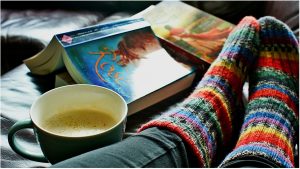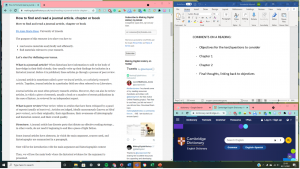This week’s Active Online Reading post from one of our student researchers is from Annabelle Mansell a 3rd year Classical Studies student at the University of Lincoln. In the post, Annabelle outlines her strategies (and technologies) for productive reading.
When it comes to reading novels, my approach has always been to settle down in a comfy spot, pull a book from my shelf and read, cosy in the lowlight for hours on end. This, as I am finally starting to understand in my final year of university, is not how I like to approach academic texts.

Firstly, although I love having physical copies of articles to scribble over, highlight, and drown in sticky notes, I have found it simply isn’t practical to print or borrow everything I need to read; printing excessively is environmentally damaging and, frankly, I hate writing on books. I still try to get physical copies when I need to translate, as annotating directly works best for me, but I now mostly prefer to use digital copies.
Secondly, when I sit down to read, the environment is very different to my cosy nook. Depending on my mood and the piece I’m reading, I’ll either sit squarely at my desktop computer, or I’ll use my laptop so I can move about. I’ll go to different rooms as I deem fit, or I’ll walk to a study spot or café to switch up the scenery and keep my brain fresh. The tiny breaks this travel provides also gives me a chance to stretch, realign my focus, and take stock. I love these micro-breaks, and having the reading digitally accessible on a reasonably sized laptop screen that I can take anywhere is imperative for me when I am in this mood.

I also lay out my computer screens in a very specific, sectioned way. I always divide the screen so I can see multiple things at once, often splitting it with a dictionary so that I can look up any words, my music player (only when reading light texts, as I am aware of the risks of too much split-focus), and the Word document that I am using to take notes (if it isn’t Talis Elevate, which is occasionally my preferred annotation tool, depending on my mood). I find that this ‘business’ stops me from getting distracted and keeps me focussed as I never need to minimise the reading and it stays at the forefront of my mind. Sometimes I will read aloud for the same reason, and I always write comments as I read. If I am reading a document that I want to save, I use an app named Zotero to sort, tag, and leave notes on the reading, ready to read it again digitally in the future, so I will sometimes have Zotero open too.

Because I use so many apps and digital features, I have also learnt to set up clear boundaries to stop myself getting distracted playing games or watching shows. I use an app named Forest to set up a timer during which key websites will be blacklisted, physically inaccessible. I know I walk a fine line between not enough stimuli and too much, and between too much routine and not enough, so I am interested to learn how others balance these when using technology to access readings, and to learn how the format of reading and our reading environments affect how we engage.